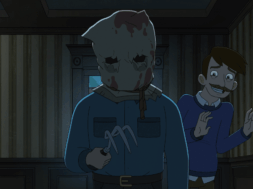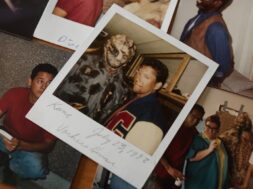[Cinepocalypse Review] Mechanical ‘The Devil’s Doorway’ Plays Like a Collection of Horror’s Greatest Hits
Stop me if you’ve heard this one: there’s something strange going on at a home for young women. An older priest and a younger priest are called to investigate. After increasingly mounting signs, they discover something demonic at work and must fight back against these evil forces. Oh, and it’s all shot first-person, found footage style. Does any of this sound familiar?
I don’t mean to suggest that The Devil’s Doorway, the debut feature from Irish filmmaker Aislinn Clarke, is ripping off one single movie. But watching it during its Midwest Premiere at Chicago’s Cinepocalypse film festival, it was hard to shake the feeling that the movie plays like a collection of Horror’s Greatest Hits. Found footage? Check. Demonic possession? Check. Creepy nuns? Check. Children’s laughter? Check. Loud noises? Check. That it’s packaged all up in a single film couldn’t quite outweigh the fact that it’s all been done before.
But here’s the thing: it’s all done very well. If you are someone who likes the found footage aesthetic and/or is creeped out by religious horror, there’s a very strong chance that The Devil’s Doorway will play like gangbusters. I have to admit that both sides of that equation tend to leave me cold, so I may not be the intended audience for this particular movie. As an outside observer, however, I can still appreciate how well Clarke constructs the scares and pays off the moments of dread. This is a very well-made movie, one which first and foremost wants to be completely scary. That’s worth something.

It’s 1960 in Ireland, and young Father John (Ciaran Flynn) and the older Father Thomas (Lalor Roddy in an impressive performance) are sent by the Vatican to investigate a series of incidents taking place at a home for wayward young women. The statue of the Virgin Mary is bleeding from the eyes. Father John decides to document everything with his 16mm camera, the footage from which comprises the entirety of the movie. Father Thomas remains doubtful of a supernatural presence, but the more evil the two men discover, the harder it becomes to deny the presence of the Devil at work.
There are limitations and questions that immediately arise as a result of Clarke’s decision to shoot the movie as found footage (Who was responsible for editing this? How did Father John never have to put on a new reel of film? If he’s shooting 16mm, where is the camera noise?), but these are problems inherent in almost every movie shot in this style. We have to be willing to accept the aesthetic. Clarke uses it to her benefit to; by telling the story from a subjective POV, we as the audience are restricted to only what Father John’s camera can capture. It forces us to look and see only where the filmmaker wants, which also makes it easier to create spooky noises and jump scares just outside our limited field of vision. Again, these things are true of every found footage movie in theory, but not every found footage movie is able to put it into practice as well as this one does.
The scares can be effective, too, as though Clarke made a checklist of all the stuff that tends to scare us (minus clowns…there are no clowns) and went right down the list. Possessed nuns are scary, and dark tunnels are scary, and dozens of hands appearing in a doorway is scary, and menacing children’s laughter is scary. All this stuff is executed well, but it also feels kind of perfunctory. It’s going to play upon every nerve and fear of some viewers, but once I became aware of just how many familiar tropes The Devil’s Doorway was leaning on, it all started to feel mechanical.
My reaction to The Devil’s Doorway really begins and ends with the fact that it’s not for me. The performances are good, the technique impressive, the atmosphere effective. All of it works the way it’s intended to work, provided you’re not too quickly reminded of a dozen other movies that have covered the same ground. Aislinn Clarke has made a good film. Now I’m excited to see her make a film that feels more her own.










